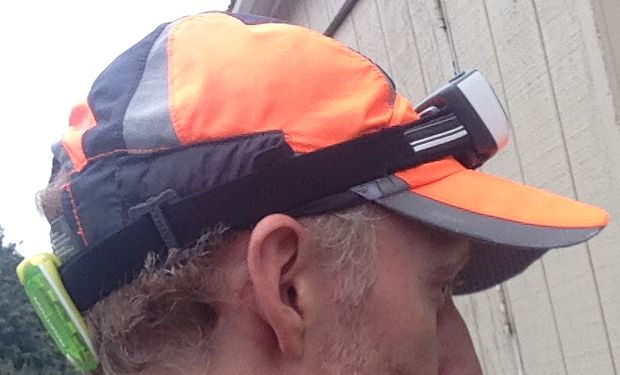Winter Running Equipment Guide Head to Toe
Posted by Adam Stuhlfaut, Director of Running on
Rainy season is almost upon us here in the Pacific Northwest. Starting soon, and for the next few months, our days will turn wetter and darker. Having the proper equipment is key to winter running and walking happiness. Below is a head-to-toe guide to thriving in the PNW winter.
Safety
Staying safe should always be the number one priority.Runners and walkers should not take unnecessary risks in the dark months by not being visible to car traffic, and not being able to see what is in front of them.My neighborhood does not have sidewalks or street lights and many people are out running or walking their dogs with no reflectivity, no lights or anything to help drivers see them better. Don’t over estimate how much drivers can see you. It’s dangerous. Check out this journal article from researchers at Queensland University in Australia.
The following three items are a necessity for outdoor activity in the dark:
- Headlamp – Helps both to illuminate your field of vision and also helps drivers see you. Get 100+ lumen if in urban areas with streetlights, 150+ on streets without streetlights and 180+ on the trails. I use the Halo Fire Runner’s Headlamp that we sell in the store. On its brightest setting its 288 lumen, has flashing strobe lights and is rechargeable. (see picture below)
- Reflective vest – Don’t rely on reflective materials built into athletic apparel. Those reflective elements are typically not big enough nor truly reflective enough. Neon colors are good for dawn and dusk where there is some light to see color. In the pitch black of night, colors cannot be seen, neon or not. Standard neon does not glow in the dark.
- Blinking light – A blinking or flashing light greatly enhances your visibility. Blinking lights are cheap too, $10 or less. I clip my blinking light on the back of my headlamp strap so the two stay together (see picture below). Many reflective vests have blinking lights built into them as well.
Apparel & Shoes
The key to apparel is to wear the correct materials. At SHOES-n-FEET, we have a saying that Cotton is Rotten. In the summer, this is true because cotton holds on to sweat and stink and is the main cause of blisters, calluses and other foot ailments like foot fungus. In the rainy months, cotton will absorb water, get heavy and get cold. Wet cotton clothes will give you severe chafing at minimum, and at worse can lead to hypothermia. The best material to wear for socks and base layers is wool. Wool sheds water better than any other fabric material, plus it retains warmth when it gets wet.
-
Head – Wear a non-cotton baseball style hat to keep the rain out of your eyes. Look for ultra-thin polyester-based materials like in my favorite Brooks run hat (pictured beow). The key is to keep the material thin. Some people wear a thicker hat with the idea it will keep them warm, however the thicker material will only absorb more water. Think of your hat like a windbreaker for your head. It is okay for your head to get a little wet, but wet and windy will make you very cold.

My favorite Brooks rainy season hat plus headlamp and blinking light.
-
Upper body – The core area around the shoulders and chest are the most important area to regulate wetness and temperature. The big mistake people make is over dressing for the weather. Your body will heat up. Dress like the temperature is ten to fifteen-degrees warmer than the thermometer reads. Dress too warmly and you will sweat too much inside your rain jacket. My favorite jacket is the Stormy Trail Jacket by The North Face. It’s thin, lightweight and does its main job of keeping me dry. If my upper core stays dry, I often get away with just wearing a singlet or light t-shirt under the thin rain jacket.
-
Lower body – As long as my upper core is warm, my legs will stay warm. The key to the lower body then is to reduce friction. Heavy rain pants will just drag and cause friction, as will wearing loose fitting shorts. On the rainiest days, I wear half-tights or three-quarter tights. I rarely wear full-length tights because of concerns of over-heating. If you are not comfortable with wearing tights as-is, just throw a pair of light, thin polyester shorts over the tights for modesty.
- Feet – As with the lower body, if the upper core is warm, my feet will stay warm with a little help from wool socks. Some runners seek out Gore-Tex or waterproof running shoes to keep the water out. The problem is that if you sweat inside the shoes, or step in a puddle that sloshes over the sides of the shoes, the feet stay wet inside the shoe. I once got frostbite on a toe from icy water sloshing in a Gore-Tex lined shoe. Wearing standard mesh athletic shoes will allow for breathability and water drainage. Over the last two years, I’ve run in my Gore-Tex Brooks Ghost running shoes a total of four times. They are great in the snow and bitter cold, but not in the rain. Finally, to reduce friction between my toes, I always wear wool Injinji toe socks.
